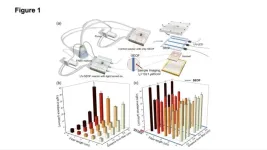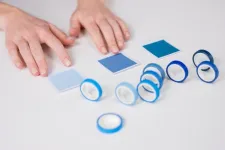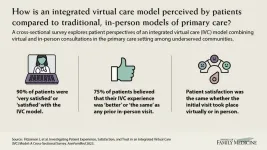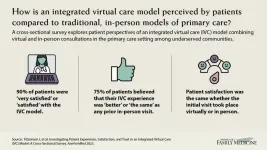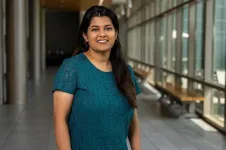(Press-News.org) Bacterial biofilms are clusters of microorganisms that form on wetted surfaces virtually everywhere. They harbor pathogens that compromise water quality, and they can disrupt the operation of many different engineered systems through the corrosion, fouling and clogging of tanks, pipes and valves.
In some settings, they could even be deadly. Space suits that enable crew operations outside of the International Space Station use recirculating water to regulate body temperatures in the orbital extremes of full sun (250 F) and full shade (-250 F). But biofilms blooming in those water lines have nearly compromised astronaut safety during spacewalks.
Ultraviolet, or UV, light offers an effective, chemical-free means of controlling this problem by damaging the DNA and enzyme repair systems of microbes—which leads to their demise. But the UV lamps commonly used for disinfecting water bring the risk of hazardous material leaks because they are mercury-based. Additionally, their designs are not practical for narrow-diameter tubing and other tight spaces where biofilms are likely to grow.
Seeking a practical solution, Arizona State University researchers collaborated with the start-up company H2Optic Insights to develop a novel method of using UV light, specifically shorter-wavelength UV-C, to inhibit biofilm growth in almost any space. The results of their work are published in the July issue of the journal Nature Water.
“Ultraviolet light has been extensively studied for its ability to deactivate bacteria and microorganisms in water,” said Paul Westerhoff, the corresponding author of the paper and a professor of civil and environmental engineering in ASU’s Ira A. Fulton Schools of Engineering. “But there is limited research on its effectiveness against bacteria in established biofilms, and a key challenge in biofilm research using UV-C light is delivering light effectively to surfaces in pressurized water systems.”
Westerhoff and his team overcame this challenge by using LEDs connected to thin, side-emitting optical fibers, or SEOFs, placed directly on surfaces where biofilms can develop. The team successfully inhibited biofilm growth by delivering UV-C light through SEOFs at wavelengths of 265 or 275 nanometers and at low irradiance levels, just above a threshold of 9 µW/cm2.
The study also considered the impact of different UV wavelengths on biofilm inhibition, revealing that UV-A and UV-B had negligible effects at low irradiance levels where UV-C was effective. Westerhoff and his team further demonstrated that intermittent cycling of UV-C—with 10 minutes of irradiation followed by 50 minutes of dark time—achieved results comparable to continuous light exposure. That meant reducing energy use by more than 80%.
“From a design perspective, SEOFs offer a flexible solution for effectively illuminating extensive surface areas within narrow pipes or irregularly shaped surfaces,” said Westerhoff, who also is deputy director of the National Science Foundation Nanosystems Engineering Research Center on Nanotechnology-Enabled Water Treatment, or NEWT. “This can be achieved using either a single SEOF or multiple SEOFs integrated into mesh designs.”
He said SEOFs also have the potential to revolutionize the design of apparatus for biofilm control since they can deliver UV at any wavelengths to surfaces where biofilms can develop and without the need to account for complications like light absorption or scattering through water, which would be a concern when using a point source LED to illuminate a surface.
“Using UV-C LEDs with SEOFs shows real promise in combating biofilms in water systems, particularly in enclosed and flowing water systems where traditional light delivery methods are limited,” said Westerhoff. “So, these findings contribute to improving the safety, performance and energy efficiency of water treatment systems, including in challenging environments like the International Space Station.”
Westerhoff said further research is required to explore how biofilms at various stages of development respond to UV light of different wavelengths. There also is a need to optimize the UV-SEOF method for different applications, such as biomedical devices and energy systems.
Other authors of the Nature Water paper are Zhe Zhao, Nora Shapiro, François Perreault and Bruce Rittmann—all from ASU—as well as Hojung Rho from the Korea Institute of Civil Engineering and Building Technology and Li Ling from the Advanced Interdisciplinary Institute of Environment and Ecology at Beijing Normal University.
END
Shedding light on a dark problem
ASU research delivers UV-C in a novel way to defeat bacteria in tight spaces
2023-07-25
ELSE PRESS RELEASES FROM THIS DATE:
Scientists may have discovered mechanism behind cognitive decline in aging
2023-07-25
AURORA, Colo. (July 25, 2023) – Scientists at the University of Colorado Anschutz Medical Campus have discovered what they believe to be the central mechanism behind cognitive decline associated with normal aging.
“The mechanism involves the mis-regulation of a brain protein known as CaMKII which is crucial for memory and learning,” said the study’s co-senior author Ulli Bayer, PhD, professor of pharmacology at the University of Colorado School of Medicine. “This study directly suggests specific pharmacological treatment strategies.”
The study was published today in the journal `Science Signaling.’
Researchers using ...
Study shows that the shape of objects could be perceived via vision and touch
2023-07-25
Study shows that the shape of objects could be perceived via vision and touch; the inferolateral occipitotemporal cortex selectively encodes object shape even in people who become blind from a very early age, suggesting that the brain is organized as operators that execute a given function regardless of input senses.
#####
In your coverage, please use this URL to provide access to the freely available paper in PLOS Biology: http://journals.plos.org/plosbiology/article?id=10.1371/journal.pbio.3001930
Article Title: Similar object shape representation encoded in the inferolateral occipitotemporal ...
Understanding social media discussions about female genital mutilation
2023-07-25
Conversations on social media about female genital mutilation (FGM) have not changed dramatically over the five years to 2020, according to an analysis of English Twitter data, though there was a shift from raising awareness to calling for an end to the practice. Earlier on, users discussing the topic were mainly from the USA and UK, but later the majority came from Nigeria and Kenya. The research, published in PLOS Global Public Health, may be useful in informing communication and designing culturally effective campaigns ...
Researchers examine the impact of loan repayment program enrollment on physician workforce equity and patient care access
2023-07-25
Researchers from the American Board of Family Medicine and the University of Minnesota Medical School investigated whether participation in medical school repayment programs impacted the care family physicians provided to patients post graduation. By analyzing data from over 10,000 American Board of Family Medicine National Graduate Survey respondents, the authors examined differences in program participation, participant demographics, scope of practice, and the likelihood of serving medically underserved or rural populations.
The study revealed a significant increase in participation in the Public Service Loan Forgiveness (PSLF) program between 2016 and 2020, while participation ...
Calling for cancer centers to lead on climate disaster preparedness
2023-07-25
MIAMI, FLORIDA (JULY 25, 2023) – Cancer centers are uniquely positioned to protect communities and their most vulnerable residents – cancer patients – from climate-driven disasters by bolstering emergency preparedness, noted researchers with Sylvester Comprehensive Cancer Center at the University of Miami Miller School of Medicine, the American Cancer Society (ACS) and collaborating organizations.
Writing in a commentary in the Journal of the National Cancer Institute (NCI), the researchers noted that all 71* of the country’s NCI-designated ...
July/August 2023 Annals of Family Medicine Tip Sheet
2023-07-25
Canadian Patients Report High Levels of Satisfaction From an Integrated Model of Virtual and In-Person Care
In an effort to increase access to care in underserved communities, researchers from the University of Ottawa evaluated the implementation of an integrated virtual care (IVC) model. Their study evaluated the overall experience and satisfaction of patients receiving care through a combination of virtual and in-person visits. A secondary aim was to compare the experiences of patients who had been previously seen in person by a family physician before transitioning to the IVC clinics with those who met their family physician virtually for the first ...
Navigating telemedicine implementation: exploring experiences of primary care clinicians early in the COVID-19 pandemic
2023-07-25
Researchers from Virginia Commonwealth University and Case Western Reserve University conducted weekly and monthly surveys of primary care clinicians to examine the use of telemedicine during the COVID-19 pandemic. The e-surveys were conducted between March 2020 and March 2022 and used convenience sampling. A total of 36 surveys were completed, with an average of 937 respondents per survey, representing clinicians from all 50 states and from multiple specialties.
Initially, respondents reported difficulties in implementing telemedicine, citing challenges with infrastructure and reimbursement mechanisms. However, as time progressed, attitudes toward telemedicine became ...
Canadian patients report high levels of satisfaction from an integrated model of virtual and in-person care
2023-07-25
In an effort to increase access to care in underserved communities, researchers from the University of Ottawa evaluated the implementation of an integrated virtual care (IVC) model. Their study evaluated the overall experience and satisfaction of patients receiving care through a combination of virtual and in-person visits. A secondary aim was to compare the experiences of patients who had been previously seen in person by a family physician before transitioning to the IVC clinics with those who met their family physician virtually for the ...
Researchers unveil the role of primary cilia in facilitating cartilage regeneration after growth plate fractures
2023-07-25
Growth plates (GP), situated at the ends of long bones in children, supply chondrocytes necessary for bone growth. Damage to the growth plate due to fractures often results in arrested bone growth, making it a significant cause of skeletal disorders in children. However, a small percentage of these injuries astonishingly manage to heal themselves, a phenomenon that had remained a mystery until now.
In a new study published in International Journal of Oral Science, Yao Sun from Tongji University and other researchers identified that primary cilia, cellular ...
HPV vaccine cost reimbursement could hinder vaccine access, study suggests
2023-07-25
Bare minimum reimbursement rates could be a factor in why some clinics may be struggling to offer HPV vaccination in the U.S.
MUSC Hollings Cancer Center researcher Kalyani Sonawane, Ph.D., and a team of researchers from South Carolina and Texas decided to quantify private insurance reimbursement rates for the HPV vaccine after several qualitative studies noted that health care providers were dissatisfied with HPV vaccine reimbursement by private insurance companies.
The results of their investigation were published July 24 in the Annals of Family Medicine.
They found that ...
LAST 30 PRESS RELEASES:
New software sheds light on cancer’s hidden genetic networks
UT Health San Antonio awarded $3 million in CPRIT grants to bolster cancer research and prevention efforts in South Texas
Third symposium spotlights global challenge of new contaminants in China’s fight against pollution
From straw to soil harmony: International team reveals how biochar supercharges carbon-smart farming
Myeloma: How AI is redrawing the map of cancer care
Manhattan E. Charurat, Ph.D., MHS invested as the Homer and Martha Gudelsky Distinguished Professor in Medicine at the University of Maryland School of Medicine
Insilico Medicine’s Pharma.AI Q4 Winter Launch Recap: Revolutionizing drug discovery with cutting-edge AI innovations, accelerating the path to pharmaceutical superintelligence
Nanoplastics have diet-dependent impacts on digestive system health
Brain neuron death occurs throughout life and increases with age, a natural human protein drug may halt neuron death in Alzheimer’s disease
SPIE and CLP announce the recipients of the 2025 Advanced Photonics Young Innovator Award
Lessons from the Caldor Fire’s Christmas Valley ‘Miracle’
Ant societies rose by trading individual protection for collective power
Research reveals how ancient viral DNA shapes early embryonic development
A molecular gatekeeper that controls protein synthesis
New ‘cloaking device’ concept to shield sensitive tech from magnetic fields
Researchers show impact of mountain building and climate change on alpine biodiversity
Study models the transition from Neanderthals to modern humans in Europe
University of Phoenix College of Doctoral Studies releases white paper on AI-driven skilling to reduce burnout and restore worker autonomy
AIs fail at the game of visual “telephone”
The levers for a sustainable food system
Potential changes in US homelessness by ending federal support for housing first programs
Vulnerability of large language models to prompt injection when providing medical advice
Researchers develop new system for high-energy-density, long-life, multi-electron transfer bromine-based flow batteries
Ending federal support for housing first programs could increase U.S. homelessness by 5% in one year, new JAMA study finds
New research uncovers molecular ‘safety switch’ shielding cancers from immune attack
Bacteria resisting viral infection can still sink carbon to ocean floor
Younger biological age may increase depression risk in older women during COVID-19
Bharat Innovates 2026 National Basecamp Showcases India’s Most Promising Deep-Tech Ventures
Here’s what determines whether your income level rises or falls
SCIE indexation achievement: Celebrate with Space: Science & Technology
[Press-News.org] Shedding light on a dark problemASU research delivers UV-C in a novel way to defeat bacteria in tight spaces
